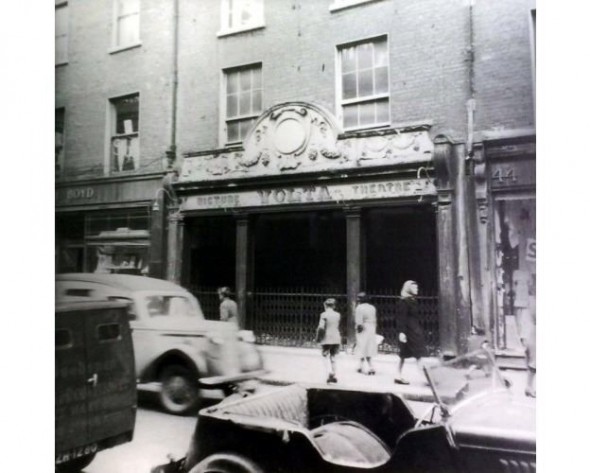Joyce’s electric theatre

On 20 December 1909, with funding from business acquaintances from Trieste, James Joyce opened the Volta Cinematograph, Ireland’s first dedicated cinema. The Volta’s first screenings were French and Italian in origin, and included Bewitched Castle, The First Paris Orphanage and Mario Caserini’s expressionistic Tragic Story of Beatrice Cenci, which, the Freeman’s Journal said, “was hardly as exhilarating a subject as one could desire on the eve of the festive season but it was very much appreciated and applauded.” Handbills carried synopses of the stories in English and admittance started at 2d. Luke McKernan’s Bioscope offers up some stills from some early screenings.
As this StoryMap film recounts (thanks, Nessa), Joyce was involved in the development of the Volta, from the securing of the building on Mary Street, to the fitting out of the venue, to promoting the coming attractions with sandwich board men, and to the hiring of the projectionist, Lennie Collinge. Collinge described Joyce, at the time virtually unknown in the world of letters, as ‘soft spoken’ and very retiring,’ ‘never at the cutting edge of developments.’
While Collinge worked in Irish cinema for 64 years, Joyce did not, returning to Trieste in January 1910, citing trouble with his eyes. While no doubt true – he was troubled with failing vision his entire adult life – Kevin Rockett has a further theory as to why Joyce only stuck it out for seven months.
“From his letters to Nora, he clearly had little time for the Dublin theatre audience. He didn’t like the crude way they responded to shows. Bear in mind the Volta was located on the edge of a tenement district, so there were probably a lot of boisterous children in, so that’s fair. Joyce also thought he should get more money. He probably worked extremely hard, and his highly inflated expectations of getting profits out of the cinema were of course not realised. But Joyce’s many money schemes, of which this is just one, usually ended in failure.”
The cinema continued until 1948, but as the Lyceum, or ‘louse house’ as it was dubbed by locals.

Joyce was an enthusiast filmgoer and his exposure to cinema, and his borrowing from the medium – most prominently in the Circe episode in Ulysses – has been explored in several essays and books (see Roll Away the Reel World), but what’s also interesting is Joyce’s influence on cinema: from Sergei Eisenstein (“Many things he did are now impossible; here he goes beyond the limits of literature, and a whole new series of thngs which are very difficult to do in a work of literature can now be done much more easily in another art form. From Joyce the next leap is to film, where it’s much easier…this Joyce couldn’t show.”) to Woody Allen (“You probably wondered, why all the references to Dublin?”, Crimes and Misdemeanours), to Hugo, Martin Scorsese’s love letter to early cinema, a film that brings us, appropriately enough, full circle back to the Volta:
The camera briefly alights on a startled James Joyce, then a resident of Paris, who had returned in 1909 to Dublin to open the city’s first purpose-built cinema, the Volta. Appropriately its premiere kicked off with a short called The First Paris Orphanage. At the time Hugo is set, Joyce was writing Finnegans Wake, a novel in the form of a dream in which he refers to the Marx brothers.

